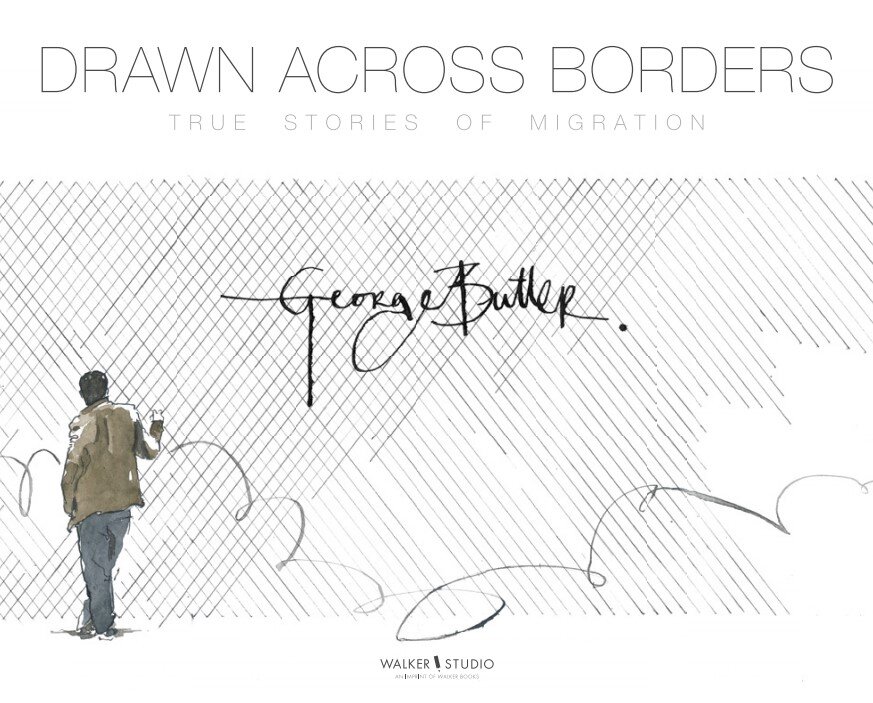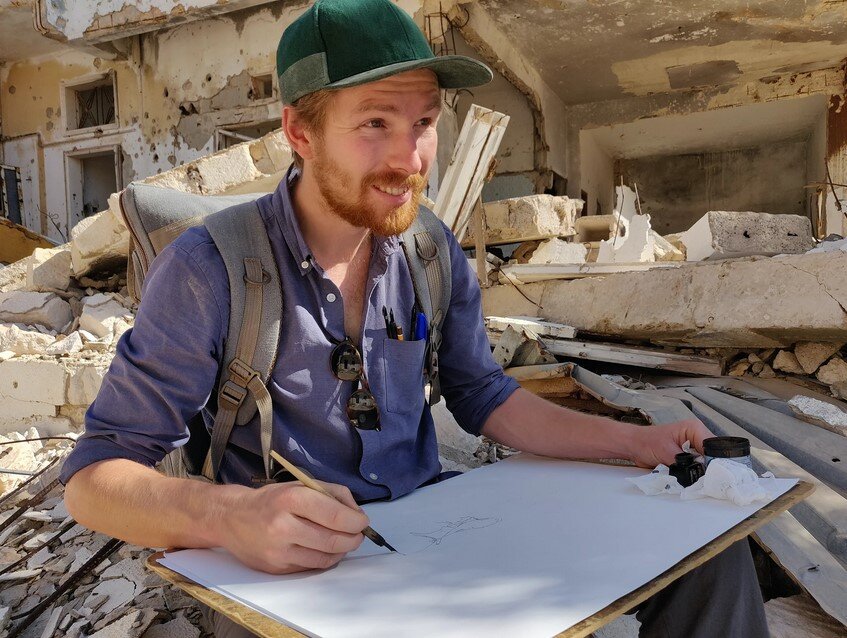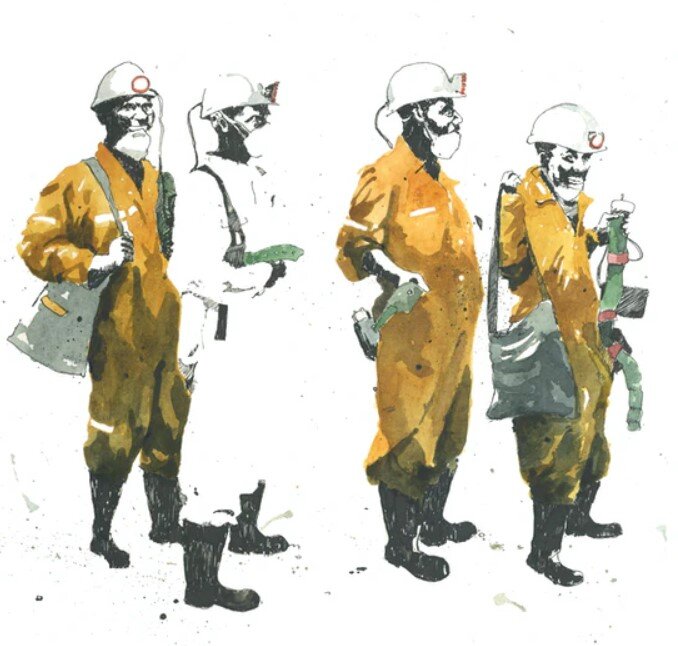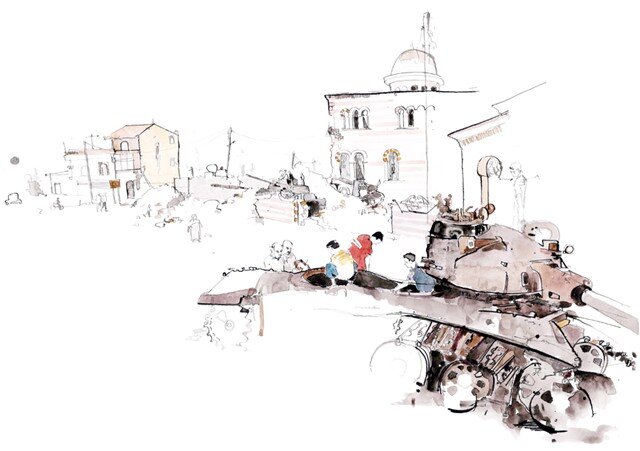Ep 15 - Drawing Across Borders with George Butler
In this episode of the SneakyArt Podcast, I spoke with British artist George Butler, who makes ink/watercolor drawings of people in conflict-zones and refugee camps all over the world. His latest book (Drawn Across Borders) tells the migration stories of 12 individuals, compiled from travels over the past decade. Modern reasons for migration, legal or otherwise, include political upheaval, civil strife, proxy wars, and, increasingly, climate change. But human migration, he argues, is a basic feature of human existence, and has been so for hundreds of thousands of years. In this respect, George and I talk about the importance of sharing individual stories. I ask him about drawing scenes that are not conventionally pretty, and whether it is possible to find art in such environments. This leads to a deeper discussion about the power of illustration - what the artist puts into it and what the viewer derives from it - and thus the broader purpose of what we call art.
Links
Book link - https://www.georgebutler.org/pages/new-book
George Butler’s Website - https://www.georgebutler.org/
George Butler’s Instagram - https://www.instagram.com/georgebutlerillustration/?hl=en
Transcript
Hello and welcome to the SneakyArt Podcast. I'm your host, Nishant Jain. This is a show where I speak with artists who draw or paint their worlds from observation. My guests include watercolorists, line-artists, educators, travelers, architects and designers. What unites them is a love for the urban environment and human activity. Their art brings out beauty in the ordinary things of life, places and people that we are surrounded by, but rarely acknowledge or appreciate. On this show, I speak with them about the why of their art as well as the how, trying to uncover not just where they're coming from, but what they see, the ways they interpret their vision, and where they want to go with their finished work.
In today's episode, I speak with George Butler, a British artist who travels to war-zones, conflict areas, and refugee camps all over the world, making ink and watercolor drawings of people and their lives. His paintings capture humanity confronting some of its greatest traumas, circumstances that are unchanged over the centuries despite our armchair notions of love or peace or global human rights. In his work we see lives displaced by war, famine, and political instability, people affected directly and indirectly by geopolitical games.
We discuss anecdotes from George's new book, where he presents stories of human migration, compiled from a decade of making art in such places as Syria, Afghanistan, Tajikistan, Kenya, Iraq, Myanmar, and Eastern Europe.
This book 'Drawn Across Borders' shares the lives of 12 people, living in circumstances that might seem unimaginable or cruel to many of us. How do they find home again? How do they settle in the foreign places they go, sometimes temporarily, often under oppressive conditions, usually without basic rights or freedom? Migration is a basic human practice. As George points out, it is a fundamental reality of human existence, and has been this way for hundreds of thousands of years. In fact, it is how we trace the paths of human history itself. The people in this book are often powerless before the mighty waves that wreck their lives and destroy their worlds, but also enormously resilient to keep standing, finding ways to live, things to smile about, moments to laugh and share, finding hope even in great tragedy.
Buy the book from the link in the shownotes. There is also a link to George's website, and his Instagram page.
In this conversation, I ask him how he came to be an illustrator in such dire places. Can we find art in such an environment? Is there a special use of such traditional art in a world saturated by multiple forms of media? What chance does an illustration stand? For example, what does it matter that one artist sat to watch a queue of people trying to enter the Serbian border, and that one little girl spotted him drawing and smiled and waved?
Today's episode is brought to you by Robert, Sreethi, Malvinder, Becky, Dinah, Barbara, Patti, Irina, Meg, Clare, Santosh, Mark, Fisto and Myshell. Thank you for buying me coffee, and for your encouraging words that keep this show going. I hope you enjoy this episode too.
If you enjoy this show, and if a particular episode has inspired you in any way, if you find that this episode moves you, you can now support my work directly. Visit the link in the shownotes to buy me a coffee, and also consider it an opportunity to start a conversation. Tell me what you liked, what worked for you, and how it affected your ideas about art. I would love to hear from you.
Okay. With that out of the way, let's begin this episode...
5:00 Official start, asking where and how the subject of human migration occurred to him.
"It just so happened that in the places I had been drawing ... Iraq and Syria ... people were moving. When I walking into Syria, documenting front line forces in Mosul, people were going the other way. It wasn't by accident, but it soon became the most human thing I could concentrate on. Drawing lends itself to that - allowing you the time to sit and observe people."
07:37 What is the importance of individual stories versus zooming out and taking a macroscopic view?
"I think we benefit from understanding the individual stories, and if we can hold that with the other bits we know, I think it's a fairer representation."
"The shallower understanding comes from the intimate relationship we have with our phones and the distant relationship from the people on the other end."
09:50 How did George find interest in war illustration? What inspired illustration and telling stories through the news?
Copying from magazines and elsewhere, artists like Ronald Searle (WW2 illustrator), Gerald Scarfe (political cartoonist), Feliks Topolski (painter) were inspirations.
George relates the first time he was able to travel to Afghanistan with the British Army. Since he couldn't go to the front, he was consigned to drawing at bases like Kandahar images of people going to war. He learned there that much of war happens at bases, simply waiting around for the call to action. Thus he realized drawing has a role in communicating an aspect of war, even if not alongside the news on the front-lines.
15:07 What is the role of traditional illustrations when we are so saturated by multimedia imagery of war and conflict?
They strike upon illustrations having an element of illusion - the wonder of "how it might be done" - which leads to people spending a little more time with an illustration than with a photographer.
The phrase - "Buying time" from the audience. Whatever you can do to trick people into spending more time with an image.
George talks about how time works in both directions - both in the viewer granting time to look at an illustration, and the artist giving their time to sit with a subject or a scene.
They discuss what it is like to bring people's attention to subject matter that is unpleasant or disturbing.
"The role of the artist is that, even in those difficult moments, to make something beautiful enough that you would look at it. And there's a ... conflict, that these things may not be beautiful to look at, may in fact be very sad (or upsetting), but they still have to 'look good'."
"... The idea that something that isn't attractive, has to be good looking enough to capture people's attention."
"The interest has to come from the artist."
27:18 About showing up and having the faith that you will find something art-worthy, something inspiring.
How do you find stories, which part of the world and where do you go once you're there?
George relates how opportunities and interest took him to different places. And how some stories come to him simply by virtue of his inconspicuous presence, his still position, as an artist at the periphery of a scene.
Is there a sense of mental conflict or is there resonance between the things George wants to capture and the things that do the job best + the things that get published most easily?
Nishant asks about drawing within various constraints - tools, time, comfort level, location, the attention of people around him.
George addresses how his tools help him to mentally prepare for the circumstances around him, and how the environment (heat etc) must be embraced in order for him to continue.
45:00 George relates the experience of visiting a children's hospital in Syria, feeling out of place, and hiding behind his art-board to complete the drawing. Talks about how he confronted the feeling of futility and helplessness.
"Illustration tends to be biased towards the subject."
Nishant suggests that the feeling of futility and conflict is perhaps the essential human feeling at that time. And that we have to lower those barriers to feel something, so that we can capture something real.
------------------- Break in Conversation…
53:07
At this point, we took a short break while George took a phone call. While we wait for him to return, let's examine what he said about illustrations being biased towards the subject. I am thinking of the media coverage we see of wars and conflicts, the money that goes into supporting the news channels, and the interests that are protected as a result. George talked also about the importance of individual stories, in a time when we are trained to zoom out and look at the big picture.
Illustrations are biased towards the subject. And we need that. We need someone to speak for the powerless individual - the young shepherd in Tajikistan waiting for his father to return from Russia, an economic nomad in Kenya drifting in search of gainful employment, a young Yazidi girl chasing rabbits in a makeshift camp on top of a hill, or her mother who ran out of their home minutes before it was bombed, with nothing but what she could grab with her two hands.
In the second half of this episode, I chat with George about some of these specific instances. We speak about finding subjects of art in such environments. George reveals people's stubborn will to live, to make a home, to improve their lives and the lives of their communities. They regard him and react to his presence in different ways - as an object of curiosity, as a potential savior, on some occasions as an opportunist profitting off their miseries. In some ways, the world he paints is so radically different from anything I or you have seen, but in some ways it is also exactly the same. Children play, whether in a park or in rubble. Elders sit and wax nostalgic about past days. Young people look for urgent solutions to their life's circumstances, taking radical steps to make a better life.
Once again, I highly recommend you buy the book, using the links in the episode description. And while you're there, also consider supporting this show by clicking the link to buy me a coffee. It is literally that easy to help make this show happen. I loved speaking with George, and I feel that artists like him are the reason I started this podcast in the first place. But I'm a solo podcaster, and I take great pride in following my own compass and doing things myself. By buying me a cup of coffee, you help me to continue this way as an independent podcaster, finding artists that pique my curiosity, and sharing their stories with you in the way that I like.
George is taking a while, so here's another reason to participate in this kind of independent support. I think of this show as a deal between you and me, just me creating this and just you listening to it. It's an equation I am comfortable with, because it lets me focus on my job, which is to make a great show. And if you're still listening to me talk, I think you agree we have a good thing here. So, click the link to buy me a coffee. Take it as an opportunity to also start a conversation - tell me what you like, who you wish I'd speak to next, and what I can do to make the show even better. Conversations over coffee are nice, even when virtual. This month, I am offering a bonus commentary on my Buy Me A Coffee page, covering some of the more interesting tangents from this conversation - it includes a profile of an artist who inspired George's creative journey, a graphic novelist whose work tuned me into the ravages of war, and a brief history of war illustration as it began close to 150 years ago. If you like this conversation, I think you will like this as well.
Now, it seems George is back from his mysterious important phone call. And we can resume our conversation. Let's back into it...
------------------- Conversation Resumes…
57:33 What was your first time like, drawing on location?
George relates the experience of drawing a fire-station in NYC, in his search to draw something that "has not been put on paper before". Relates how he plucked up the courage to approach the firemen to show them the drawings and the ensuing interaction he was able to have.
Nishant asks if human interaction with his subjects is something that George seeks or avoids as an on-location sketcher.
George relates another experience in Mosul where his presence was of no use, and he felt utterly helpless. And being there as a "journalist" he affected the scene but could not aid in any way.
George relates an experience drawing a prisoner in a Syrian jail, and his own misreading of the situation because of the language barrier. Relates a similar experience with Russian soldiers in Armenia.
George talks about migration that is a conscious choice and a luxury versus the migration he witnessed which was forced upon people by political or economic circumstances.
85:00 GB talks about how he pitches ideas for stories, and how he finds himself able to do what he wants to do.
GB talks about the first and last pages of his book, where he has drawn a seemingly random set of objects that are actually not so random.
They talk about the drawing at the Yazidi camp.
They discuss how simple stories can potentially move us, help us relate to people far away, and possibly re-humanize them in a media atmosphere that is geared towards macroscopic emotionless news coverage.
Nishant's last question about a recent development in India-England relations.




